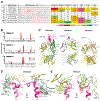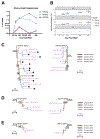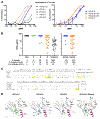Longitudinal Analysis Reveals Early Development of Three MPER-Directed Neutralizing Antibody Lineages from an HIV-1-Infected Individual
- PMID: 30876875
- PMCID: PMC6555550
- DOI: 10.1016/j.immuni.2019.02.008
Longitudinal Analysis Reveals Early Development of Three MPER-Directed Neutralizing Antibody Lineages from an HIV-1-Infected Individual
Abstract
Lineage-based vaccine design is an attractive approach for eliciting broadly neutralizing antibodies (bNAbs) against HIV-1. However, most bNAb lineages studied to date have features indicative of unusual recombination and/or development. From an individual in the prospective RV217 cohort, we identified three lineages of bNAbs targeting the membrane-proximal external region (MPER) of the HIV-1 envelope. Antibodies RV217-VRC42.01, -VRC43.01, and -VRC46.01 used distinct modes of recognition and neutralized 96%, 62%, and 30%, respectively, of a 208-strain virus panel. All three lineages had modest levels of somatic hypermutation and normal antibody-loop lengths and were initiated by the founder virus MPER. The broadest lineage, VRC42, was similar to the known bNAb 4E10. A multimeric immunogen based on the founder MPER activated B cells bearing the unmutated common ancestor of VRC42, with modest maturation of early VRC42 intermediates imparting neutralization breadth. These features suggest that VRC42 may be a promising template for lineage-based vaccine design.
Keywords: HIV envelope; neutralizing antibody; next-generation sequencing.
Published by Elsevier Inc.
Figures







Similar articles
-
Dependence on a variable residue limits the breadth of an HIV MPER neutralizing antibody, despite convergent evolution with broadly neutralizing antibodies.PLoS Pathog. 2022 Sep 2;18(9):e1010450. doi: 10.1371/journal.ppat.1010450. eCollection 2022 Sep. PLoS Pathog. 2022. PMID: 36054228 Free PMC article.
-
Anti-V3/Glycan and Anti-MPER Neutralizing Antibodies, but Not Anti-V2/Glycan Site Antibodies, Are Strongly Associated with Greater Anti-HIV-1 Neutralization Breadth and Potency.J Virol. 2015 May;89(10):5264-75. doi: 10.1128/JVI.00129-15. Epub 2015 Feb 11. J Virol. 2015. PMID: 25673728 Free PMC article.
-
Evaluation of a novel multi-immunogen vaccine strategy for targeting 4E10/10E8 neutralizing epitopes on HIV-1 gp41 membrane proximal external region.Virology. 2017 May;505:113-126. doi: 10.1016/j.virol.2017.02.015. Epub 2017 Feb 23. Virology. 2017. PMID: 28237764 Free PMC article.
-
Neutralizing Antibodies Targeting HIV-1 gp41.Viruses. 2020 Oct 23;12(11):1210. doi: 10.3390/v12111210. Viruses. 2020. PMID: 33114242 Free PMC article. Review.
-
The development of HIV vaccines targeting gp41 membrane-proximal external region (MPER): challenges and prospects.Protein Cell. 2018 Jul;9(7):596-615. doi: 10.1007/s13238-018-0534-7. Epub 2018 Apr 17. Protein Cell. 2018. PMID: 29667004 Free PMC article. Review.
Cited by
-
Coevolution of HIV-1 and broadly neutralizing antibodies.Curr Opin HIV AIDS. 2019 Jul;14(4):286-293. doi: 10.1097/COH.0000000000000550. Curr Opin HIV AIDS. 2019. PMID: 30994504 Free PMC article. Review.
-
HIV-1 Entry and Prospects for Protecting against Infection.Microorganisms. 2021 Jan 22;9(2):228. doi: 10.3390/microorganisms9020228. Microorganisms. 2021. PMID: 33499233 Free PMC article. Review.
-
Functional Delineation of a Protein-Membrane Interaction Hotspot Site on the HIV-1 Neutralizing Antibody 10E8.Int J Mol Sci. 2022 Sep 15;23(18):10767. doi: 10.3390/ijms231810767. Int J Mol Sci. 2022. PMID: 36142694 Free PMC article.
-
SIV infection duration largely determines broadening of neutralizing antibody response in macaques.J Clin Invest. 2020 Oct 1;130(10):5413-5424. doi: 10.1172/JCI139123. J Clin Invest. 2020. PMID: 32663192 Free PMC article.
-
Progress and Challenges in HIV-1 Vaccine Research: A Comprehensive Overview.Vaccines (Basel). 2025 Jan 31;13(2):148. doi: 10.3390/vaccines13020148. Vaccines (Basel). 2025. PMID: 40006695 Free PMC article. Review.
References
-
- Abbott RK, Lee JH, Menis S, Skog P, Rossi M, Ota T, Kulp DW, Bhullar D, Kalyuzhniy O, Havenar-Daughton C, et al. (2018). Precursor Frequency and Affinity Determine B Cell Competitive Fitness in Germinal Centers, Tested with Germline-Targeting HIV Vaccine Immunogens. Immunity 48, 133–146 e136. - PMC - PubMed
-
- Adams PD, Grosse-Kunstleve RW, Hung LW, Ioerger TR, McCoy AJ, Moriarty NW, Read RJ, Sacchettini JC, Sauter NK, and Terwilliger TC (2002). PHENIX: building new software for automated crystallographic structure determination. Acta Crystallogr D Biol Crystallogr 58, 1948–1954. - PubMed
-
- Alam SM, McAdams M, Boren D, Rak M, Scearce RM, Gao F, Camacho ZT, Gewirth D, Kelsoe G, Chen P, et al. (2007). The role of antibody polyspecificity and lipid reactivity in binding of broadly neutralizing anti-HIV-1 envelope human monoclonal antibodies 2F5 and 4E10 to glycoprotein 41 membrane proximal envelope epitopes. J Immunol 178, 4424–4435. - PMC - PubMed
Publication types
MeSH terms
Substances
Grants and funding
LinkOut - more resources
Full Text Sources
Other Literature Sources
Molecular Biology Databases

